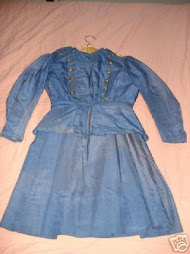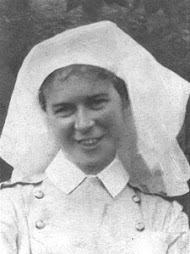Friday, October 26, 2012
Mysteries and Memorials
Well, today I have two nursing sister mysteries and one memorial to share with you. First, the mysteries. One of the great pleasures of blogging is the opportunity to connect with readers from all over the world. Recently, I received an email from Marie Nolan of Ireland who wants to find out more about a nurse ancestor who died during the Great War. This nurse really was a “nursing sister” as you will see from the email and photo sent to me by Marie:
“Hello Debbie, The attached photo of sister Clesus is I believe an ancestor of mine as it was found in my family photos which my Great Grand Mother would have had received from Canada, and a number of her siblings I was told went to Canada around the famine in mid nineteen hundreds. As you can see from writing on photo, Sister Clesus died while nursing wounded soldiers during 1914 to 1918 World War 1 in France. I was trying for quite a while to trace sister in photo without success and when I saw your request for information on the nursing sisters I thought it was worth a try. I have a family heirloom with names Nolans entwined in Quebec 1877. If you are interested I can give you more information that might help. Thanking you, Marie Nolan, Dublin, Ireland”
This is an intriguing story, and I would love to be able to publish more information about this nurse who died in France. If you have any leads or suggestions for Marie, please comment on this blog or email me at the address given in my profile on this blog.
Shortly after hearing from Marie, I received another nursing sister query. It was from Australian historian Dr. Kirsty Harris, author of the book: More than Bombs and Bandages: Australian Army Nurses at Work in World War I (Big Sky Publishing, 2011. She wrote:
“Hello from down under in Australia. I am trying to track down the Canadian background of Miss Ethel Rose Collins who served with the Queen Alexandra’s Imperial Military Nursing Service in World War I. She had left Canada by the end of 1906 when she joined the QAs and she survived the war and went on to a senior position in the service... I would greatly appreciate if you are able to provide any information about her before the entry in the The Canadian Nurse journal in 1906 which says she received an appointment to the QAs – shown as Miss E.R. Collins. I’ve seen the journal online but the search mechanism doesn’t pick up the word Collins.
I am working on a project which looks at Empire nurses at Gallipoli in 1915 and Collins was a matron on a hospital ship there, hence my desire for more information on her. All best wishes, Kirsty Harris”
Any help with these enquiries would be so much appreciated. Send a comment or drop me a line at the email address provided in my profile.
Death in the Cruelest Month: Nursing Sister Matilda Ethel Green
Most people associate the Great War with trench warfare and the immense and terrible loss of life. It must have seemed especially cruel to families to get to the end of that horrific conflict only to lose a family member on the precipice of peace. Many nurses, as well as soldiers, died in the last few months of war to a formidable enemy sweeping the world at that time—the Spanish influenza. One of the victims of the flu was Nursing Sister Matilda Ethel Green.
Born in Listowel, Ontario, on August 14, 1886, Matilda Green was the daughter of Susan Samantha Zimmerman, an Ontario-born woman of Dutch heritage. Her father was James Green, a Scottish-born farmer. According to the 1901 census, Matilda had two sisters: Ada (born 1872) and Ellen (born 1876), along with four brothers: Thomas (born 1874), Frank (born 1881), George (born 1882), and Harold (born 1884). The family had a farm they called “Girdwood” in Harmsworth, Manitoba.
Sadly, James died sometime after 1901. By 1906, Harold was helping his mother oversee the farm. Matilda would eventually make her own way to the Medicine Hat General Hospital in Alberta, where she would train as a nurse. Medicine Hat General was built in 1889 and was the first regularly equipped hospital to open a school of nursing west of Winnipeg. The two and a half storey hospital building was of cut stone. The mansard roof covered the third level that housed an isolation ward and the nurses.
According to a nursing history website, “One of the major rules for the new nurses was: Every nurse will be expected to perform any duty assigned to her either as a nurse in the hospital, or when sent to private cases among the rich or poor, in any part of the Territories." "Any part of the Territories", covered the area from the forty-ninth parallel to the Arctic and from Winnipeg to the Rocky Mountains.
The hospital’s nursing school (opened in 1895) provided most of the nursing care given on the wards. They were often “instructed" by other young women who had been in the same position only two or three months earlier, although they also seem to have sometimes been supervised by more senior nurses. They worked twelve hour shifts on average.
After graduation, Matilda continued to work at the hospital. Then, on April 23, 1917, she joined the Canadian Army Medical Corps. She was 30 years old, five feet, four and a half inches tall, weighing roughly 130 pounds.
On arrival in England in June 1917, she was taken on strength at the Ontario Military Hospital in Orpington, Kent. Built in 1915 with funds provided by the Ontario government, the hospital had about 1,000 beds for sick and wounded soldiers (rising to 2,000 by 1918). By the end of the war, over 26,000 men would be treated there.
Matilda arrived at the hospital just in time to witness history being made. One of the staff—dietician and nursing sister Roberta MacAdams—was running as a “soldier’s candidate” in the Alberta provincial election. In the fall, MacAdams would win her seat, becoming one of the first two women elected to a legislature anywhere in the British Empire.
In September 1918, Matilda was sent to France, to serve as a temporary reinforcement. Just over a month later, she was admitted to #24 Canadian General Hospital, Etaples, seriously ill with “lobar pneumonia” “following influenza” (according to her military records and the journal Canadian Nurse). On October 9, she would die of the illness. There is little doubt that she had contracted the dreaded Spanish flu that was sweeping across Europe and which would ultimately take more lives than the Great War. On March 29, 1920, the name of Matilda Ethel Green, along with that of other nurses from the Ontario Military Hospital who gave their lives during the Great War, was commemorated on a brass plaque at the legislative chamber at Ontario’s Parliament Building in Toronto, Ontario.
Subscribe to:
Post Comments (Atom)






















No comments:
Post a Comment